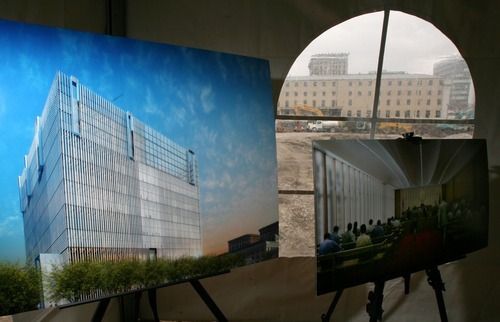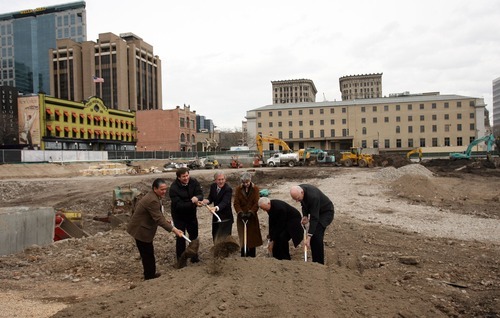This is an archived article that was published on sltrib.com in 2011, and information in the article may be outdated. It is provided only for personal research purposes and may not be reprinted.
The handwritten letter that arrived at U.S. District Court Judge Tena Campbell's chambers didn't mince words.
"You are going to die by the bullet!" Matthew Bernard Hale, 30, wrote in an angry rant to the federal judge who ordered his friends to prison for committing gang crimes. "Once I'm free your ass is dead."
Campbell reported the letter to police, and authorities in turn interviewed Hale at the Utah State Prison in 2009. Hale admitted to threatening the judge and his confession resulted in a federal indictment, which this winter landed him a 37-month prison sentence after he pleaded guilty to one count of felony retaliation against a federal judge.
Cases such as Hale's are unfortunately a part of life for federal judges, who receive letters from disgruntled defendants or others connected to a case who are upset over judges' decisions in court.
At Salt Lake City's new federal courthouse, slated for completion in 2014, judges may find themselves feeling slightly safer thanks to a focus on improving security at the facility, which recently broke ground and is now under construction at 351 West Temple.
Discussion over a new federal courthouse started in 1992 when government officials deemed the Frank E. Moss Courthouse unsatisfactory for security reasons because prisoners, judges and the public cannot be routed down separate corridors.
The new federal courthouse will be equipped with better technology and will have a U.S. Marshals office inside, said U.S. District Court Clerk of Court Mark Jones.
There will be separate elevators for defendants, judges and the public. That means inmates shackled in handcuffs and dressed in jail jumpsuits will be less likely to come face to face with their victims as everyone makes their way to the courtroom.
"The [building's] design will lend itself to having it be more secure for the judges, staff and for the public,"Jones said.
Security concerns at the existing courthouse were renewed in January, in the wake of the Arizona shooting carried out by 22-year-old Jared Loughner that left six dead as well as critical injuries to Rep. Gabrielle Giffords. Among those killed was Arizona's chief federal judge John Roll. Although his death was at random while he stopped at a grocery store to say hello to Giffords, a longtime friend, the scenario prompted discussion about how to handle situations where judges may be targeted.
"Whenever something like this happens, there is discussion about what type of situations do we need to be aware of," Jones said in January, after the mass shooting in Arizona. "What are the type of situations judges should be nervous about?"
Jones, administrator for the court, says the U.S. Marshal Service works closely with judges to educate them and to communicate in cases where threats prompt extra security both in and out of the courtroom.
Judges sometimes will ask for extra security — or the U.S. Marshals Service on its own will provide increased security — when a case is particularly controversial. For example, at the late February trial of 29-year-old climate activist Tim DeChristopher, the public had to go through an extra security screening before entering Judge Dee Benson's courtroom. Several Salt Lake City police officers patrolled the area outside the courthouse throughout the proceedings, as protests unfolded in support of DeChristopher, who was later convicted of two felonies for misrepresenting himself and placing bogus bids at a federal oil and gas lease auction.
Paul Cassell, a former federal judge and current University of Utah law professor, said he never doubted security at the federal courthouse in Salt Lake City when he served on the bench. But once outside the confines of the courthouse, he worried.
His family received a home security system as part of a program to improve safety for federal judges. Anyone with enough motive could track down a judge if they wanted to, he said. "It is a serious problem, because federal judges create a lot of enemies on the bench. It's difficult to provide 24-hour, 7-day-a-week safety," Cassell said.
"One of the things I tried to do was to work very hard to keep my home address and other locating information hard to find. But judges have had a public life before they go on the bench and anybody can see what they look like."
While officials acknowledge it is impossible to prevent defendants and others in the public from attacking judges through letters or disruptive behavior, Jones said improved security measures at the new courthouse will help to bring peace of mind and help to stop potential problems before they happen. —
New courthouse a $226 million project
The new $226 million courthouse will include nine courtrooms, 14 judge's chambers and office support spaces. Parking will be included below the building. The 409,397-square-foot facility is located west of the Frank E. Moss U.S. Courthouse at 350 S. Main St.
Tenants at the new courthouse include the U.S. District Court, probation and pretrial services office, and the U.S. Marshals Service. The Moss Courthouse will house the bankruptcy judges, the U.S. Attorney's Office and U.S. Trustee.
The federal government spent $6.5 million to move and clean up the historic Odd Fellows Hall, which sat on the site of the new courthouse. It was sold at auction for $1.2 million in September.











